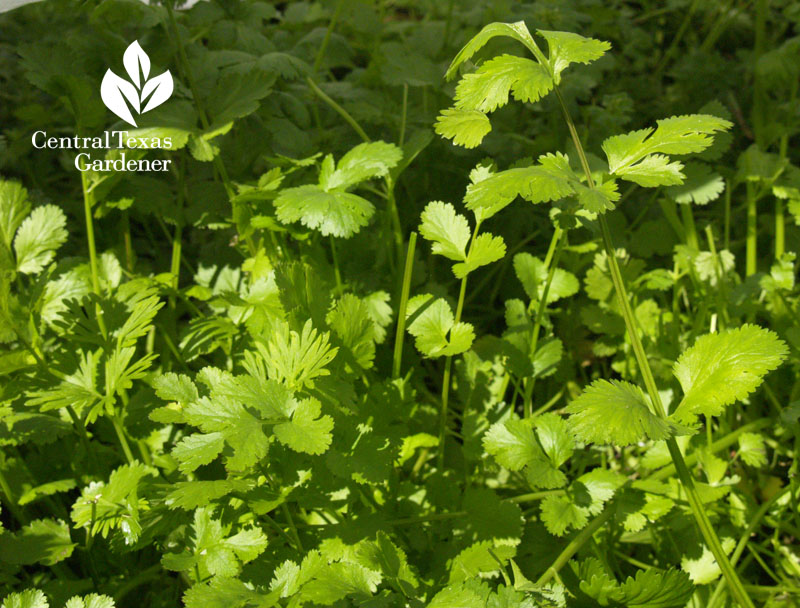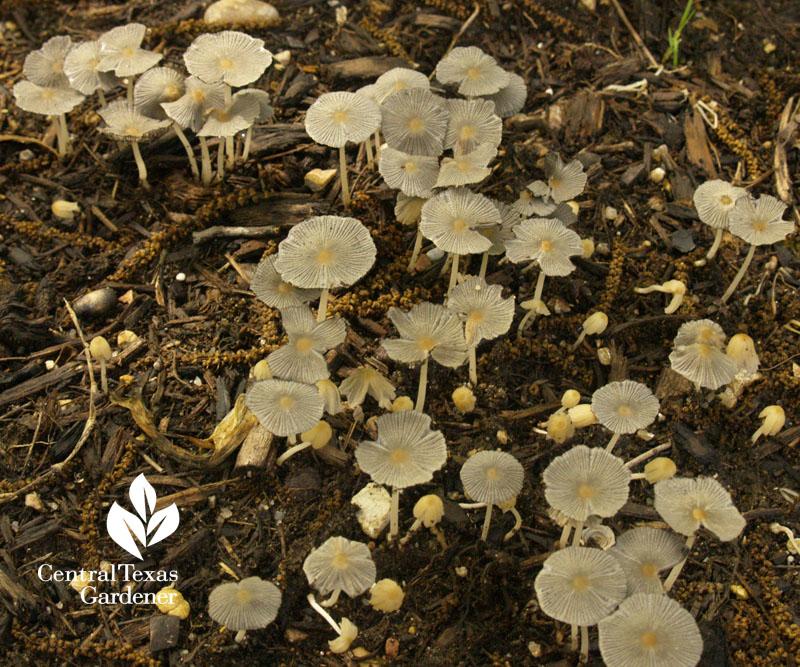September 21, 2017
Ann McCormick Winter Herbs + Mushroom Farm
Most of my roses don’t form hips, but my native Turk’s caps sure do! These nickel-sized edible fruits are packed with Vitamin C, but I leave them for foraging wildlife in my garden. If you want to try them, they taste like apples.

Lots of flying insects are really sucking up to my neighbor’s vibrant Salvia microphylla.

We’re all chomping at the bit to get cool weather herbs and vegetables in the ground. Unless you’re starting seeds in containers or flats, the soil is still too hot and moisture is only in the air.
For now, renew your beds with compost and a granular slow release fertilizer. Water deeply the next few weeks to blend in your amendments and to moisten really dry soil. This really makes a difference if you grow in raised beds.
This week, effervescent Herb ‘n Cowgirl Ann McCormick takes the challenge out of growing cilantro!

Although we often add it to hot, spicy dishes, it’s a cool weather annual (and acquired taste for many!). We can start seeding once soil temperatures drop to 70° or below. I usually cover mine with floating row cover when frosts are imminent, in case we dip below freezing. Ann also recommends succession planting, starting again in January.

Once weather warms up in spring, it will bolt and flower. Leave the flowers to attract pollinators and collect the seeds to use as coriander or to save for next year.

Ann also takes us on a tour of historical herbs used at the birth of Jesus! Watch now!
So, what’s going on with Elizabeth Chinnault’s ‘Jane’ magnolia tree? Although it bloomed last spring, its leaves yellowed and browned by mid-summer.


Daphne explains why this cultivar may not be the best suited for Central Texas. And, in years when fungal disease runs rampant, we shouldn’t spray fungicides once temperatures are over 85°. Get her complete answer!

Our plant this week, along with a great tip, comes from viewer Janis. A few years ago, a friend of hers in Rockport shared divisions of Hymenocallis, a summer-blooming bulb for part shade. They’re often called spider lily.

Here’s her tip for these strappy, summer showoffs: Janis keeps them in kiddie pools, which helps greatly to conserve water. She drills extra holes about an inch from the bottom of each pot, all the way around, so they can draw up the water they need. Like a wicking bed!
She also drills small holes just above the soil line, near the top of each pot, so that when it does rain, water doesn’t collect at the top of the pots and rot the bulbs.
Since we like to grow indoors, too, John shows how to cultivate sculptural tillandsias inside.

Of course, we’ve got our native tillandsias, ball moss, that are often free for the picking!

A fabulous find of driftwood makes an artistic mount.

Brandi Kinslow from The Natural Gardener was a good sport to “model” this stunning planter!

Author Zenaida Sengo details gorgeous designs and plants with air plants. Watch now!

Viewer Heather Kinley crafted hers into a decorative wreath. She changes out the ornaments and adds different flowers to match the season.

Where do mushrooms come from? In our gardens, the mycelium can be visible in our mulch.


The beneficial organisms—that stringy white stuff—can navigate to cardboard.

In my own garden, I got tons of mushrooms when I laid down cardboard under mulch to banish grass. Although you can buy mycelium to nourish your plants, naturally growing mushrooms are a treasure to value.

On tour in Wimberley, young farmers Megan McFarland and Adam Vicknair cultivated their love of fungi to provide edible specialty, medicinal and regional mushrooms for discerning restaurants.

Although they recently closed the business, it’s fascinating to see their cultivation from spores to harvest in autoclavable myco bags.



Lucky gardeners close to mushroom farms know the nourishing value of mushroom compost.

Some mushrooms actually growing on trees can be a sign of trouble, like shelf fungi.

On fallen logs, though, Megan explains how to insert shiitake mushroom spores.

Garden mushrooms are signs of good soil health, but they could poison you. Never harvest wild mushrooms if you don’t know what they are!
As Megan tells us, “They say that there are old mushroom hunters and there are bold mushroom hunters but there are no old bold mushroom hunters.”
Watch now!
Thanks for stopping by! See you next week, Linda







